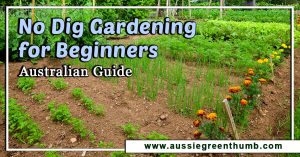Living near the ocean is something most Australians dream about, with around 85% of us living within 50km of the coast. The obvious charms that draw people there are great, but what about for the humble gardener?
Coastal areas are notoriously tough places to successfully grow a backyard garden. The strong salty winds and poor quality sandy soils can make even the simplest gardening tasks a nightmare.
But don’t throw away your coastal garden paradise dreams just yet! Here are our top tips for coastal gardening.
More...
Tips for Coastal Gardening Around Australia
How to Prep Your Coastal Garden's Soil
Like every garden, it all starts with the soil. Coastal areas traditionally have poor quality, sandy soils with little to no nutrients or water holding capacity. This isn’t great for most gardening needs, so this is really the best place to start.
The first thing we need to do is to build some structure in the soil. Sand has amazing drainage qualities but doesn’t hold a lot of water, which can lead to dry and dead plants come summer time. It can also easily be blown away, exposing plant roots which leads to more drying out.
To fix this, we need to add some organic matter into the sandy garden beds. The more humus we can add, the more loamy the soil becomes, and the better it will be at holding moisture and the roots of our plants.
Read more on what is loam soil here.
Composted manures, humus or garden mix from landscape supply stores will do the job.
An important tip here is to not use potting mix! Like sand, this is really light and free flowing, meaning water will drain straight through and it can be a huge waste of time, and money.
Adding this organic matter will also help with the second step in preparing your soil; nutrients!
Coastal soils are usually low in nutrients, as the rich topsoil is the first to blow away in a wind storm. Adding your own, and mixing it through the soil will help provide your plants with the nutrients they need to thrive.
Selecting the Right Coastal Garden Plants
This is the easiest way you can have an amazing backyard garden in a coastal area. Australian natives have evolved to grow in this inhospitable place, and nowadays there are a bunch of cultivars and hybrids that give incredible beauty, as well as retaining their toughness.
There are also a fair few African and Mediterranean exotics that suit the bill as well. You might need to change your garden plans a bit to suit , but it will definitely pay off.
There are literally hundreds of plants that will suit a coastal gardens, and it will really come down to a personal preference, but here’s a few little tips to keep an eye out for when selecting plants.
- Look at the leaves - The waxy, hairy, narrow and leathery leaves of a lot of native plants will be able to tolerate the corrosive salty winds a lot better than those of delicate European plants.
- Drought resistance - Plants that advertise, or are known for their drought resistance are a good choice. Strong winds can dry the soil out really quickly, meaning that moisture stress can become a real problem if your plants can’t handle it.
- Flexible stems for wind - Those strong coastal winds can cause a lot of damage to your plants if they’re not flexible enough. Unfortunately, stiff and rigid plants or hedges are a no go here.
- 'Coastal' in the name - This one is a dead give away when selecting plants for a coastal garden. Most common names for plants that suit coastal areas will contain the word ‘Coastal’ in them.
Coastal Rosemary (Westringia fruticosa), Coastal Wattle (Acacia sophorae), Coastal tea-tree (leptospermum laevigatum)... get the idea?
For more plants to grow in your coastal garden, see our growing guides for:
Using Plants in Your Garden as Wind breaks
Those strong winds that hammer your coastal garden are bad news. They dry out your soil, blow away all the nutrients, sand blast your plants, and can straight up snap them in two. But by using a wind break, we can help cut out these problems.
The trick with a good windbreak is not to try and stop the wind completely, but rather to slow it down. A few well placed trees with a bushy habit will take the brunt of the wind and slow it right down as it passes through them.
Trees like casuarina, pandanus, banksia integrifolia, acacia and grevillea are all commonly found in sand dunes and do the job perfectly and a nice meadow made of dianella, isolepsis or themeda will help slow down the wind at ground level, meaning less blown out soil.
So there you have it, a few easy steps to take to help you turn your barren coastal garden into a thriving backyard. Happy coastal gardening.
Published on July 30, 2015 by Clinton Anderson
Last Updated on July 27, 2023





#AussieGreenThumb: Coastal Gardens. – Living near the ocean is something most Australians dream about, with around… http://t.co/HEhBBRcMM4
Clinton Anderson liked this on Facebook.
Cooking Traditions with Magli liked this on Facebook.